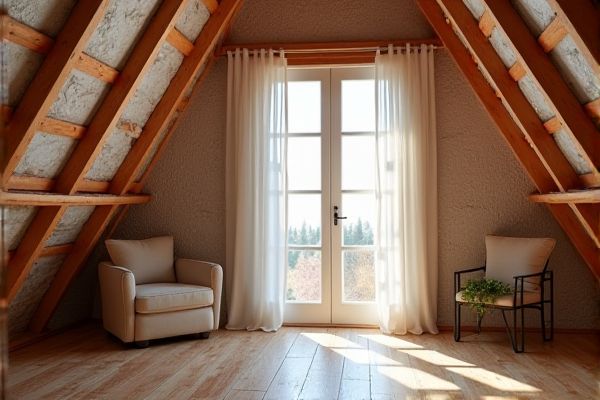
Attic blackout curtains effectively block sunlight and reduce heat gain, improving your energy efficiency and comfort during hot days, while insulation panels provide a more comprehensive thermal barrier that minimizes heat transfer year-round. Explore the rest of the article to determine which solution best suits Your attic and energy-saving needs.
Table of Comparison
| Feature | Attic Blackout Curtains | Insulation Panels |
|---|---|---|
| Primary Purpose | Light blocking and minor heat reduction | Thermal insulation and energy efficiency |
| Material | Opaque fabric, often polyester or cotton blend | Foam, fiberglass, or mineral wool |
| Thermal Performance (R-value) | Low (minimal insulation effect) | High (R-value typically between 3 to 7 per inch) |
| Installation | Easy, installs with rods or hooks | Complex, requires measurements and sealing |
| Noise Reduction | Moderate | High |
| Cost | Low to moderate | Moderate to high |
| Durability | Moderate, fabric can wear or fade | High, designed for long-term use |
| Energy Savings | Limited, mainly reduces heat from sunlight | Significant, improves thermal retention |
| Best Use | Light control and minor heat reduction in attic spaces | Thermal insulation to reduce heating and cooling costs |
Introduction to Attic Light and Heat Control
Attic blackout curtains provide effective light blocking and moderate heat control by reducing sunlight penetration and minimizing heat transfer during warmer months. Insulation panels excel in temperature regulation by creating a thermal barrier that limits heat loss in winter and heat gain in summer, enhancing overall energy efficiency. Your choice depends on whether light control or superior thermal insulation is the priority for your attic environment.
What Are Attic Blackout Curtains?
Attic blackout curtains are specialized fabric panels designed to block light and enhance thermal insulation in attic spaces, helping regulate temperature and reduce energy costs. These curtains are typically made from dense, multi-layered materials that prevent sunlight penetration and minimize heat transfer through the attic windows. Unlike insulation panels, which are rigid and installed directly on walls or ceilings, attic blackout curtains are flexible, easy to install, and can be drawn or retracted as needed for convenience.
What Are Attic Insulation Panels?
Attic insulation panels are rigid or semi-rigid boards made from materials like foam, fiberglass, or mineral wool designed to reduce heat transfer and improve energy efficiency in attic spaces. These panels help maintain consistent indoor temperatures by providing a thermal barrier, reducing heating and cooling costs. Unlike attic blackout curtains, insulation panels offer better durability and long-term thermal performance by sealing gaps and preventing air leakage.
Key Differences: Blackout Curtains vs Insulation Panels
Attic blackout curtains primarily block sunlight and reduce heat transfer through windows, enhancing privacy and energy efficiency by maintaining cooler indoor temperatures. Insulation panels, composed of materials like foam or fiberglass, provide superior thermal resistance by minimizing heat loss or gain through attic walls and ceilings, improving overall home energy performance. While blackout curtains are effective for window coverage and light control, insulation panels offer comprehensive temperature regulation and soundproofing for the entire attic space.
Energy Efficiency Comparison
Attic blackout curtains reduce heat loss and block sunlight, contributing to energy efficiency by minimizing the need for heating and cooling. Insulation panels provide a more substantial thermal barrier by trapping air and preventing heat transfer through attic walls and ceilings. Your choice depends on whether you prioritize lightweight, removable solutions or permanent, high-performance insulation for maximum energy savings.
Impact on Attic Temperature Regulation
Attic blackout curtains effectively block sunlight, reducing heat gain and helping maintain cooler temperatures during hot months, while insulation panels provide superior thermal resistance by minimizing heat transfer through attic walls and ceilings. Insulation panels contribute to consistent temperature regulation year-round, preventing heat loss in winter and heat infiltration in summer, which blackout curtains alone cannot achieve. You can optimize attic temperature control by combining both solutions, enhancing energy efficiency and comfort in your home.
Light Blocking Effectiveness
Attic blackout curtains provide superior light blocking effectiveness by using dense, multi-layered fabrics that prevent sunlight penetration, creating complete darkness ideal for bedrooms or media rooms. Insulation panels primarily focus on thermal regulation and soundproofing, offering limited light blocking capabilities due to their rigid and often perforated structure. For optimal light control in attics, blackout curtains outperform insulation panels by significantly reducing glare and UV exposure.
Installation Process & Maintenance
Attic blackout curtains offer a straightforward installation process, typically involving mounting curtain rods or hooks to secure the fabric, making them easy to remove for cleaning or replacement. Insulation panels require a more labor-intensive installation, often needing precise measurements, cutting, and securing panels directly to attic surfaces, which demands specialized tools or professional assistance. Maintenance for blackout curtains is minimal, involving periodic washing or dusting, whereas insulation panels may require inspection for damage or moisture buildup to maintain effectiveness.
Cost Comparison and Budget Considerations
Attic blackout curtains typically cost less upfront than insulation panels, making them a budget-friendly option for immediate light control. Insulation panels, while more expensive initially, offer long-term energy savings by improving thermal efficiency and reducing heating or cooling costs. Your choice depends on whether you prioritize lower initial expenses or long-term financial benefits from enhanced insulation.
Choosing the Best Solution for Your Attic
Attic blackout curtains effectively block sunlight and reduce heat gain, enhancing comfort and energy efficiency during warmer months, while insulation panels provide consistent thermal resistance, maintaining temperature stability year-round. Your choice depends on whether you prioritize light control or comprehensive insulation to improve energy savings and climate regulation. Combining both solutions can offer superior performance by addressing both heat transfer and light penetration in your attic space.
 homyna.com
homyna.com